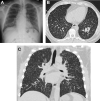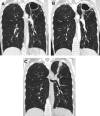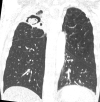Emerging Pulmonary Infections in Clinical Practice
- PMID: 38620910
- PMCID: PMC8169325
- DOI: 10.1016/j.yacr.2021.04.010
Emerging Pulmonary Infections in Clinical Practice
Keywords: Computed tomography; Emerging infections; Pulmonary infection.
Figures






























Similar articles
-
The role of 18F-Fluorodeoxyglucose Positron Emission Tomography/Computed Tomography (FDG PET/CT) in assessment of complex invasive fungal disease and opportunistic co-infections in patients with acute leukemia prior to allogeneic hematopoietic cell transplant.Transpl Infect Dis. 2021 Jun;23(3):e13547. doi: 10.1111/tid.13547. Epub 2020 Dec 28. Transpl Infect Dis. 2021. PMID: 33338319 Review.
-
How accurate is high-resolution computed tomography of the chest in differentiating between pulmonary invasive fungal infections and other pulmonary infections in children with cancer?Pediatr Radiol. 2025 Feb;55(2):268-279. doi: 10.1007/s00247-024-06112-2. Epub 2024 Dec 17. Pediatr Radiol. 2025. PMID: 39688678
-
Differential diagnosis of pulmonary infections in immunocompromised patients using high-resolution computed tomography.Eur Radiol. 2019 Nov;29(11):6089-6099. doi: 10.1007/s00330-019-06235-3. Epub 2019 May 6. Eur Radiol. 2019. PMID: 31062135
-
Pulmonary infections after renal transplantation: a prospective study from a tropical country.Transpl Int. 2021 Mar;34(3):525-534. doi: 10.1111/tri.13817. Epub 2021 Feb 26. Transpl Int. 2021. PMID: 33423313
-
Computed tomography-guided localization of pulmonary nodules prior to thoracoscopic surgery.Thorac Cancer. 2023 Jan;14(2):119-126. doi: 10.1111/1759-7714.14754. Epub 2022 Dec 8. Thorac Cancer. 2023. PMID: 36482812 Free PMC article. Review.
References
-
- Simpson S., Kay F.U., Abbara S., et al. Radiological Society of North America Expert Consensus Statement on Reporting Chest CT Findings Related to COVID-19. Endorsed by the Society of Thoracic Radiology, the American College of Radiology, and RSNA - Secondary Publication. J Thorac Imaging. 2020;35(4):219–227. - PMC - PubMed
-
- Litmanovich D.E., Chung M., R Kirkbride R., et al. Review of chest radiograph findings of COVID-19 pneumonia and suggested reporting language. J Thorac Imaging. 2020;35(6):354–360. - PubMed
Publication types
LinkOut - more resources
Full Text Sources
